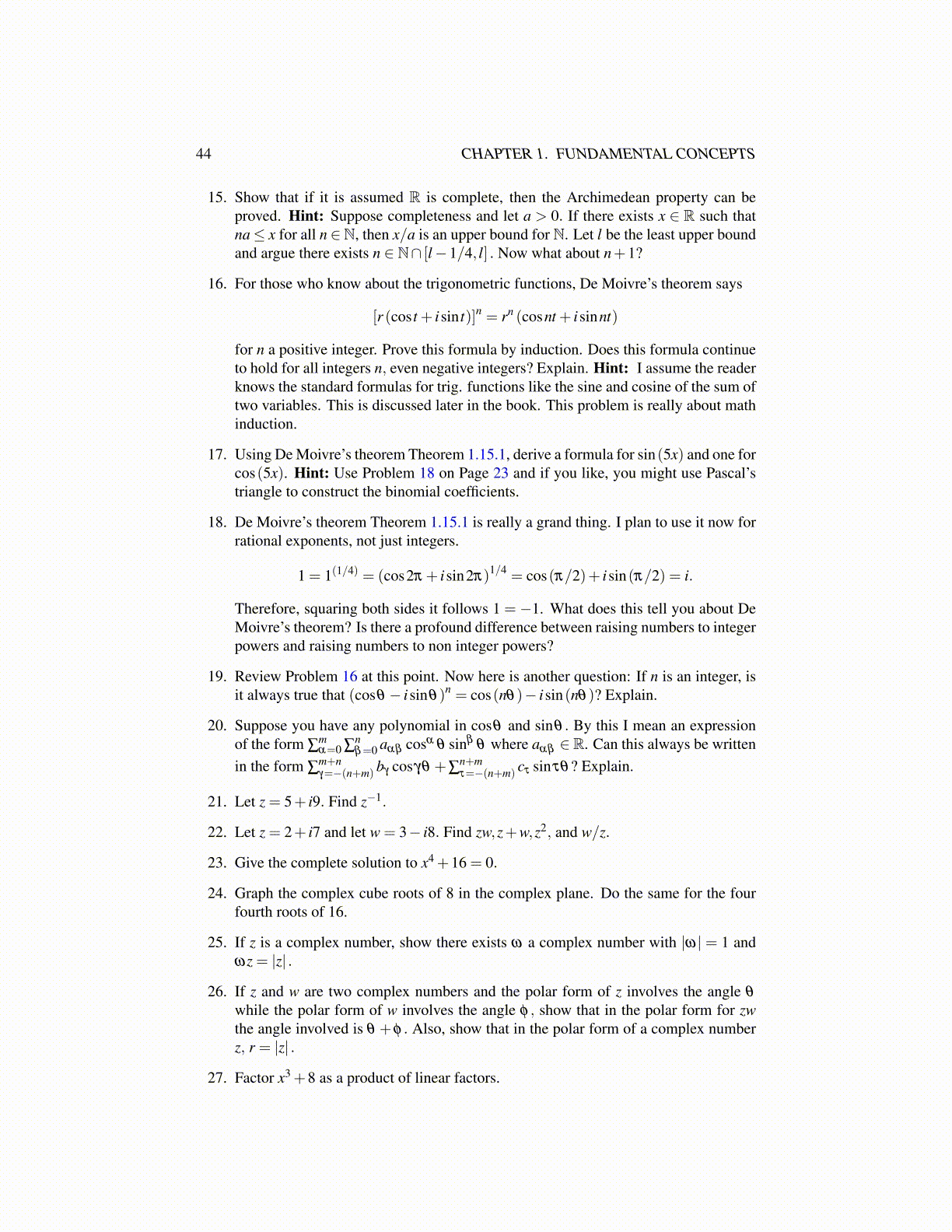
44 CHAPTER 1. FUNDAMENTAL CONCEPTS
15. Show that if it is assumed R is complete, then the Archimedean property can beproved. Hint: Suppose completeness and let a > 0. If there exists x ∈ R such thatna ≤ x for all n ∈N, then x/a is an upper bound for N. Let l be the least upper boundand argue there exists n ∈ N∩ [l −1/4, l] . Now what about n+1?
16. For those who know about the trigonometric functions, De Moivre’s theorem says
[r (cos t + isin t)]n = rn (cosnt + isinnt)
for n a positive integer. Prove this formula by induction. Does this formula continueto hold for all integers n, even negative integers? Explain. Hint: I assume the readerknows the standard formulas for trig. functions like the sine and cosine of the sum oftwo variables. This is discussed later in the book. This problem is really about mathinduction.
17. Using De Moivre’s theorem Theorem 1.15.1, derive a formula for sin(5x) and one forcos(5x). Hint: Use Problem 18 on Page 31 and if you like, you might use Pascal’striangle to construct the binomial coefficients.
18. De Moivre’s theorem Theorem 1.15.1 is really a grand thing. I plan to use it now forrational exponents, not just integers.
1 = 1(1/4) = (cos2π + isin2π)1/4 = cos(π/2)+ isin(π/2) = i.
Therefore, squaring both sides it follows 1 = −1. What does this tell you about DeMoivre’s theorem? Is there a profound difference between raising numbers to integerpowers and raising numbers to non integer powers?
19. Review Problem 16 at this point. Now here is another question: If n is an integer, isit always true that (cosθ − isinθ)n = cos(nθ)− isin(nθ)? Explain.
20. Suppose you have any polynomial in cosθ and sinθ . By this I mean an expressionof the form ∑
mα=0 ∑
nβ=0 aαβ cosα θ sinβ
θ where aαβ ∈R. Can this always be writtenin the form ∑
m+nγ=−(n+m)
bγ cosγθ +∑n+mτ=−(n+m)
cτ sinτθ? Explain.
21. Let z = 5+ i9. Find z−1.
22. Let z = 2+ i7 and let w = 3− i8. Find zw,z+w,z2, and w/z.
23. Give the complete solution to x4 +16 = 0.
24. Graph the complex cube roots of 8 in the complex plane. Do the same for the fourfourth roots of 16.
25. If z is a complex number, show there exists ω a complex number with |ω| = 1 andωz = |z| .
26. If z and w are two complex numbers and the polar form of z involves the angle θ
while the polar form of w involves the angle φ , show that in the polar form for zwthe angle involved is θ +φ . Also, show that in the polar form of a complex numberz, r = |z| .
27. Factor x3 +8 as a product of linear factors.